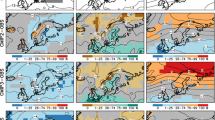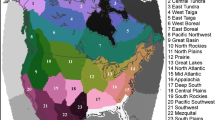Abstract
A fast simple climate modelling approach is developed for predicting and helping to understand general circulation model (GCM) simulations. We show that the simple model reproduces the GCM results accurately, for global mean surface air temperature change and global-mean heat uptake projections from 9 GCMs in the fifth coupled model inter-comparison project (CMIP5). This implies that understanding gained from idealised CO2 step experiments is applicable to policy-relevant scenario projections. Our approach is conceptually simple. It works by using the climate response to a CO2 step change taken directly from a GCM experiment. With radiative forcing from non-CO2 constituents obtained by adapting the Forster and Taylor method, we use our method to estimate results for CMIP5 representative concentration pathway (RCP) experiments for cases not run by the GCMs. We estimate differences between pairs of RCPs rather than RCP anomalies relative to the pre-industrial state. This gives better results because it makes greater use of available GCM projections. The GCMs exhibit differences in radiative forcing, which we incorporate in the simple model. We analyse the thus-completed ensemble of RCP projections. The ensemble mean changes between 1986–2005 and 2080–2099 for global temperature (heat uptake) are, for RCP8.5: 3.8 K (2.3 × 1024 J); for RCP6.0: 2.3 K (1.6 × 1024 J); for RCP4.5: 2.0 K (1.6 × 1024 J); for RCP2.6: 1.1 K (1.3 × 1024 J). The relative spread (standard deviation/ensemble mean) for these scenarios is around 0.2 and 0.15 for temperature and heat uptake respectively. We quantify the relative effect of mitigation action, through reduced emissions, via the time-dependent ratios (change in RCPx)/(change in RCP8.5), using changes with respect to pre-industrial conditions. We find that the effects of mitigation on global-mean temperature change and heat uptake are very similar across these different GCMs.









Similar content being viewed by others
References
Andrews T, Forster PM, Gregory JM (2009) A surface energy perspective on climate change. J Clim 22(10):2557–2570
Andrews T, Ringer MA, Doutriaux-Boucher M, Webb MJ (2011) Sensitivity of an earth system climate model to idealised radiative forcing. Geophys Res Lett 39:L10702. doi:10.1029/2012GL051942
Chadwick R, Wu P, Good P, Andrews T (2012) Asymmetries in tropical rainfall and circulation patterns in idealised CO2 removal experiments. Clim Dyn. doi:10.1007/s00382-012-1287-2
Forster PMD, Taylor KE (2006) Climate forcings and climate sensitivities diagnosed from coupled climate model integrations. J Clim 19(23):6181–6194
Forster P, Ramaswamy V, Artaxo P, Berntsen T, Betts R, Fahey DW, Haywood J, Lean J, Lowe DC, Myhre G, Nganga J, Prinn R, Raga G, Schulz M, Van Dorland R (2007) Changes in Atmospheric Constituents and in Radiative Forcing. In: Solomon S, Qin D, Manning M, Chen Z, Marquis M, Averyt KB, Tignor M, Miller HL (eds) Climate change 2007: the physical science basis. Contribution of working group I to the fourth assessment report of the intergovernmental panel on climate change. Cambridge University Press, Cambridge
Good P, Gregory JM, Lowe JA (2011) A step-response simple climate model to reconstruct and interpret AOGCM projections. Geophys Res Lett 38:L01703. doi:10.1029/2010GL045208
Gregory JM, PM Forster (2008) Transient climate response estimated from radiative forcing and observed temperature change. J Geophys Res 113:D23105. doi:10.1029/2008JD010405
Gregory J, Webb M (2008) Tropospheric adjustment induces a cloud component in CO2 forcing. J Clim 21(1):58–71
Gregory JM, Ingram WJ, Palmer MA, Jones GS, Stott PA, Thorpe RB, Lowe JA, Johns TC, Williams KD (2004) A new method for diagnosing radiative forcing and climate sensitivity. Geophys Res Lett 31:L03205. doi:10.1029/2003GL018747
Hansen J et al (2005) Efficacy of climate forcings. J Geophys Res Atmos 110(D18):45
Huntingford C, Cox PM (2000) An analogue model to derive additional climate change scenarios from existing GCM simulations. Clim Dyn 16(8):575–586
Knutti R et al (2008) A review of uncertainties in global temperature projections over the twenty-first century. J Clim 21(11):2651–2663
Meehl GA, Stocker TF, Collins WD, Friedlingstein P, Gaye AT, Gregory JM, Kitoh A, Knutti R, Murphy JM, Noda A, Raper SCB, Watterson IG, Weaver AJ, Zhao Z-C (2007) Global climate projections. In: Solomon S, Qin D, Manning M, Chen Z, Marquis M, Averyt KB, Tignor M, Miller HL (eds) Climate change 2007: the physical science basis. Contribution of working group I to the fourth assessment report of the intergovernmental panel on climate change. Cambridge University Press, Cambridge
Meinshausen M, Smith SJ, Calvin KV, Daniel JS, Kainuma MLT, Lamarque J-F, Matsumoto K, Montzka SA, Raper SCB, Riahi K, Thomson AM, Velders GJM, van Vuuren D (2011a). The RCP greenhouse gas concentrations and their extension from 1765 to 2300. Clim Change (Special Issue). doi:10.1007/s10584-011-0156-z
Meinshausen M, Raper SCB, Wigley TML (2011b) Emulating coupled atmosphere-ocean and carbon cycle models with a simpler model, MAGICC6—part 1: model description and calibration. Atmos Chem Phys 11:1417–1456. doi:10.5194/acp-11-1417-2011
Myhre G, Highwood EJ, Shine KP, Stordal F (1998) New estimates of radiative forcing due to well mixed greenhouse gases. Geophys Res Lett 25(14):2715–2718
Pardaens AK, Lowe JA, Brown S, Nicholls RJ, de Gusmao D (2011) Sea-level rise and impacts projections under a future scenario with large greenhouse gas emission reductions. Geophys Res Lett 38:L12604. doi:10.1029/2011GL047678
Raper SCB, Cubasch U (1996) Emulation of the results from a coupled general circulation model using a simple climate model. Geophys Res Lett 23(10):1107–1110
Raper SCB, Gregory JM, Osborn TJ (2001) Use of an upwelling-diffusion energy balance climate model to simulate and diagnose A/OGCM results. Clim Dyn 17(8):601–613
Russell GL, Gornitz V, Miller JR (2000) Regional sea level changes projected by the NASA/GISS Atmosphere-Ocean Model. Clim Dyn 16(10–11):789–797
Santer B, Wigley T, Schlesinger M, Mitchell JFB (1990) Developing climate scenarios from equilibrium GCM results. Report no. 47, Max Planck Institute for Meteorology, Hamburg
Acknowledgments
This work was supported by the Joint DECC/Defra Met Office Hadley Centre Climate Programme (GA01101). For their roles in producing, coordinating, and making available the CMIP5 model output, we acknowledge the climate modeling groups (listed in Table 1 of this paper), the World Climate Research Programme’s (WCRP) Working Group on Coupled Modelling (WGCM), and the Global Organization for Earth System Science Portals (GO-ESSP). Helpful comments from two anonymous reviewers improved the clarity of this manuscript.
Author information
Authors and Affiliations
Corresponding author
Rights and permissions
About this article
Cite this article
Good, P., Gregory, J.M., Lowe, J.A. et al. Abrupt CO2 experiments as tools for predicting and understanding CMIP5 representative concentration pathway projections. Clim Dyn 40, 1041–1053 (2013). https://doi.org/10.1007/s00382-012-1410-4
Received:
Accepted:
Published:
Issue Date:
DOI: https://doi.org/10.1007/s00382-012-1410-4




